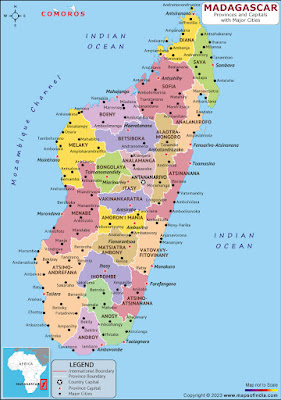Madagascar, the fourth largest island in the world, is a place like nowhere else on Earth. Known for its incredible biodiversity, unique wildlife, and dramatic landscapes, Madagascar offers travelers an immersive adventure into a world of baobab trees, lemurs, and colorful reefs.
Discover Madagascar
📍 Location: Located in the Indian Ocean off the southeastern coast of Africa.
🌳 Biodiversity Hotspot: Over 90% of its wildlife is found nowhere else on Earth, including its famous lemurs and chameleons.
🏝️ Diverse Landscapes: From rainforests and highlands to desert canyons and pristine beaches.
🌊 Marine Paradise: Home to coral reefs, whale-watching sites, and crystal-clear waters.
Top Places to Visit in Madagascar
🌳 Avenue of the Baobabs: Near Morondava, this iconic dirt road is lined with towering baobab trees, especially stunning at sunrise and sunset.
🌿 Andasibe-Mantadia National Park: Famous for the indri, the largest lemur species, and lush rainforest treks.
🏝️ Nosy Be: A tropical island paradise with beaches, diving, and marine life.
🏞️ Isalo National Park: Known for its sandstone formations, canyons, natural swimming pools, and unique flora.
🏖️ Île Sainte-Marie: Famous for whale watching from July to September and relaxed beach vibes.
🏞️ Tsingy de Bemaraha: A UNESCO World Heritage Site with sharp limestone pinnacles and rich biodiversity.
Culture and Traditions
✨ Ethnic Diversity: Home to 18 main ethnic groups, each with distinct customs and traditions.
✨ Music and Dance: Malagasy music is rhythmic, with influences from African, Asian, and French cultures.
✨ Spiritual Beliefs: Ancestor worship and traditional ceremonies remain integral to Malagasy life.
✨ Craftsmanship: Madagascar is known for its wood carvings, raffia products, and colorful textiles.
Malagasy Cuisine
🍛 Romazava: A traditional beef and greens stew.
🍚 Rice (Vary): A staple at nearly every meal.
🥘 Ravitoto: Crushed cassava leaves cooked with pork.
🐟 Fresh Seafood: Including prawns, crab, and fish along the coastal areas.
🍍 Tropical Fruits: Mangoes, lychees, and pineapples are abundant.
Why Visit Madagascar?
✅ Wildlife Encounters: Lemurs, chameleons, and endemic birds in their natural habitats.
✅ Spectacular Landscapes: From baobab-lined avenues to rainforests and beaches.
✅ Adventure Travel: Trekking, snorkeling, diving, and whale-watching.
✅ Cultural Immersion: Experience unique Malagasy traditions and crafts.
✅ Off-the-Beaten-Path: Madagascar offers unspoiled nature with fewer tourists.
Practical Travel Tips
🛂 Visa: Available on arrival for many nationalities.
🌤️ Best Time to Visit: April to December (dry season) for wildlife and outdoor activities.
🗣️ Language: Malagasy and French are official languages.
👗 Dress Comfortably: Lightweight clothing for warm weather; modest attire in villages.
Final Thoughts 🌍✨
Madagascar is a realm of natural wonders and vibrant traditions, where you can watch lemurs leap in the forests, marvel at towering baobabs, and relax on pristine beaches. For travelers seeking a truly unique African adventure, Madagascar offers a magical escape into a world unlike any other.
✈️ Curious about Africa’s 54 unique countries?
Explore them all on our Africa Main Page.
🏠 For more art, travel, and cultural stories, visit our CRA ARTS Main Page.
Have you dreamed of seeing Madagascar’s lemurs or walking under baobab giants? Share your thoughts or questions below!

Comments
Post a Comment